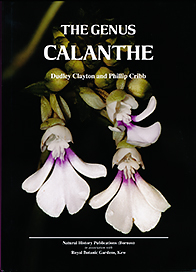The genus Calanthe.
door/by Clayton D. & Cribb Ph.
423 pp., veel kleurenillustraties/many color illustrations en/and pentekeningen/pen drawings.
Natural History Publications, Kota Kinabalu, Borneo, 2013.
ISBN 978-983-812-141-5

The ‘Introduction’ (p. 1 & 2) gives a brief overview of the genus Calanthe: from 1627 till today. Some 35 new species have been described since the year 2000. ‘Distribution’ (p. 3 - 5) informs about the distribution of Calanthe species in Southeast Asia, Africa and Central America illustrated with a world map and 2 tables with the number of endemic species per country or continent and the distribution of the number of species and endemic species by country or continent. ‘Ecology’ (p. 7-10) briefly describes the habitat in which Calanthe species occurs.
The following chapters: ‘Morphology and Anatomy’ (p. 11-12) briefly describes the morphology of the plant, flower stalk and flower; ‘Cytology’ (p. 13-15) shows in a table the chromosome numbers for several species in Calanthe; ‘Phylogeny’ (p. 17-20) discusses the origin, evolutionary history of Calanthe and relations with other related genera; ‘Pollination’ (p. 21) and ‘Conservation’ concludes these introductory chapters.
The chapter ‘Taxonomy’ (p. 23-32) deals with the taxonomy of the genus Calanthe which is divided into 2 subgenera: the subgenus Preptanthe and the subgenus Calanthe. The subgenus Calanthe is subdivided into 7 sections: Monophylla, Styloglossum, Aceratochilus, Vernae, Calanthe, Rhodochilus and Ghiesbregtia. The fifth section, Calanthe, is subdivided into 3 series. The species are listed in the subgenus, section or series.
‘Keys and Description’ (p. 33-295) is the most important chapter in this monograph. A key per subgenus, section and series leads to the species. In this chapter 207 Calanthe species are presented. A pen drawing of the lip of each species within a subgenus or section illustrates the key to the species.
For each species name, the author and the publication are given and, where applicable, the synonym names. After the description of the species, the distribution, the habitat, the altitude at which the species grows and the flowering period follows for some species additional information under the heading ‘Notes’. There is a full-page pen drawing for some species. At the back of the book we find 47 pages with color illustrations of an important number of Calanthe species.
An "Index of Synonyms and Excluded species" (pp. 297-310) is a list of synonym names, the author of those names and the publication in which they appeared.
In the chapter 'Hybridization' (pp. 311-320) both, natural and artificial hybrids are discussed.
The culture of Calanthe is explained in the chapter 'Cultivation' (pp. 321-330).
'Bibliography' (pp. 331-337), a ‘Glossary of Terms’ (pp. 338-343) and 'Bibliographical notes' (pp. 344-351) conclude this book, followed by the already mentioned color illustrations.
Conclusion.
'The Genus Calanthe' is the first monograph since Lindley catalogued the species within this genus. The book broadly follows Schlechter's classification but recognizes two subgenera (Preptanthe and Calanthe) and seven sections within the subgenus Calanthe. This book can provide a basis for further research on this orchid genus. It is a useful book for scientist, editors and orchid amateurs who are interested in Calanthe.
top
De inleiding ‘Introduction’ (p. 1 & 2) geeft kort een geschiedkundig overzicht van het geslacht Calanthe: van 1627 tot vandaag en waarbinnen sinds het jaar 2.000 nog een 35-tal nieuwe soorten beschreven zijn. ‘Distribution’ (p. 3 – 5) informeert over de verspreiding van Calanthe-soorten in Zuidoost Azië, Afrika en Centraal-Amerika aan de hand van een wereldkaart en 2 tabellen: aantal endemische soorten per land of continent, verspreiding van het aantal soorten en endemische soorten per land of continent. ‘Ecology’ (p. 7-10) beschrijft kort de habitat waarin Calanthe-soorten voor komen.
De volgende hoofdstukken: ‘Morphology and Anatomy’ (p. 11-12) beschrijft kort de morfologie van de plant, bloemstengel en bloem; ‘Cytology’ (p. 13-15) geeft aan de hand van een tabel het chromosoomnummer per soort weer; ‘Phylogeny’ (p. 17-20) bespreekt de origine, evolutionaire geschiedenis van Calanthe en de relaties met andere verwante geslachten; ‘Pollination’ (p. 21) en ‘Conservation’ sluiten deze inleidende hoofdstukken af.
Het hoofdstuk ‘Taxonomie’ (p. 23-32) behandelt de taxonomie van het geslacht Calanthe dat in 2 subgenera onderverdeel is: het subgenus Preptanthe en het subgenus Calanthe. Het subgenus Calanthe is onderverdeeld in 7 secties: Monophylla, Styloglossum, Aceratochilus, Vernae, Calanthe, Rhodochilus en Ghiesbregtia. De vijfde sectie, Calanthe, is onderverdeeld in 3 series. Per subgenus, sectie en serie worden de daarin ondergebrachte soorten vermeld.
‘Keys and Description’ (p. 33-295) is het belangrijkste hoofdstuk in deze monografie. Een sleutel per subgenus, sectie en serie leidt naar de soorten. Er worden 207 Calanthe-soorten voorgesteld. Een pentekeningen van de lip van elke soort binnen een subgenus of sectie illustreert de sleutel tot de soorten.
Bij elke soortnaam worden de auteur en de publicatie weergegeven en waar van toepassing ook de synoniemnamen. Na de beschrijving van de soort, de verspreiding, de habitat, de hoogte waarop de soort groeit en de bloeiperiode volgt bij een aantal soorten bijkomende uitleg onder de hoofding ‘Notes’. Bij enkele soorten hoort een paginagrote pentekening. Achteraan het boek vinden we 47 pagina’s met kleurenillustraties van een tamelijk aantal Calanthe-soorten.
De ‘Index of Synonyms and Excluded species’ (p. 297-310) is een lijst met synoniemnamen, de auteur van die namen en de publicatie waarin die verschenen.
In het hoofdstuk ‘Hybridization’ (p. 311-320) komen zowel natuur- als kunstmatige hybriden aan bod.
De cultuur van Calanthe wordt besproken in het hoofdstuk ‘Cultivation’ (p. 321-330).
‘Bibliography’ (p. 331-337), een verklarende woordenlijst ‘Glossary of Terms’ (p. 338-343) en ‘Bibliographical notes’ (p. 344-351) sluiten dit boek af nog gevolgd door de reeds vermelde kleurenillustraties.
Conclusie.
‘The Genus Calanthe’ is de eerste monografie sinds Lindley de soorten binnen dit geslacht catalogeerde. Het boek volgt in grote lijnen Schlechters classificatie maar erkent twee subgenera (Preptanthe en Calanthe) en zeven secties binnen het subgenus Calanthe. Dit boek kan de basis zijn voor verder onderzoek van dit orchideeëngeslacht. Het is een nuttig boek zowel voor wetenschappers, redacteurs als gewone orchideeënliefhebbers die in Calanthe geïnteresseerd zijn.
top